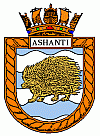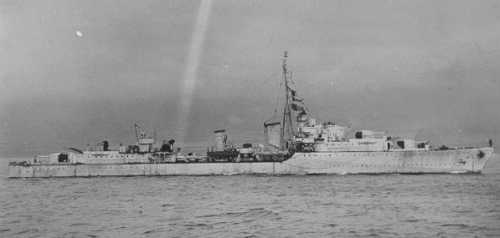| |
On 3 May 1939, Ashanti and her
sister Tribals arrived at Cherbourg, France for a good will visit. With war
looming, it seemed likely that British and French destroyers would be
working together very closely. It was important that they be friends, not
just allies. As part of the 6th Destroyer Flotilla (D.F.), Ashanti was
ordered to the Irish Sea on 1st June when it was reported that the submarine
HMS Thetis had failed to surface during her sea trials. The submarine was
located with 18 feet of her stern sticking out of the water. Four had
escaped but ninety-nine men were still trapped inside. A salvage attempt
failed and the submarine disappeared beneath the sea. When war began, the
6th D. F. was cruising with the Home Fleet and French ships in the North
Atlantic. Gradually the ships saw less and less of each other as wartime
patrols and new missions developed. Over the next several months, Ashanti's
main responsibilities were anti-submarine patrol followed by some brief
escort duties in December. Ashanti began 1940 with more anti-submarine
patrols, convoy escort duties and supporting capital ships. Seawater began
seeping into her boiler feedwater tanks so she was dry-docked for repairs at
Cowes, England on 21 March . Later on 9 April, she returned to the Home
Fleet in time to participate in the Norwegian campaign. She shared in the
fruitless sweep of the North Sea and the enemy air attacks which accompanied
those missions. While exploring a Norwegian fiord with HMS Nubian, she was
attacked by German bombers. One near miss bounced off Ashanti's side and
exploded beneath her. The main turbo-generator was blown off its bedplate by
the resultant shock and naturally, the power failed. Steering by hand from
the tiller flat, Ashanti zigzagged out of the fjord at 26 knots for a
successful escape. For most of June, July, August and September, she took
part in fleet escort duties and anti-submarine patrols in the North Atlantic
Ocean and the North Sea. By 16 October, the new British battleship HMS King
George V was nearing completion at the Vickers-Armstrong yard on the Tyne
river. That ship would need a powerful escort of cruisers and destroyers to
take her up the coast to Scapa Flow, Scotland. Ashanti and five other
destroyers were ordered to carry out a high speed run through the channel
leading to the Tyne river. Collectively, it was hoped that these ships would
produce enough magnetic and acoustic disturbance to simulate a battleship’s
passage and detonate any mines which may have been sowed in the channel by
the enemy. Surrounded by secrecy and steaming at speed in a murky drizzle,
HMS Fame ran straight onto the beach at Whitburn Rifle Range. Ashanti, doing
six knots and slightly behind her, struck Fame a glancing blow. The shock
shattered The shock shattered fuel oil pipes in both ships and HMS Fame
caught fire. HMS Maori also came too close to shallow water and sheared off
her ASDIC dome. The other ships stopped in time and no further damage
occurred. No one new why they were there or the purpose of the entire
exercise. When daylight came, it became obvious that the destroyers were
left high and dry by the receding tide. As the tide rose, the bows of many
of the destroyers held fast. The swell lifted and swung their free sterns
dropping them unto the rocks and damaging the bottom plates. Ashanti, in
particular, sustained such severe damage, that Vickers-Armstrong sent a crew
to her aid. They stripped off all armament and sealed off what they could at
low tide. On 9th of November, after two weeks of effort, Ashanti was
re-floated and taken to Sunderland, England for extensive repairs and hull
stiffening. The winter of 1940/41 proved to be a trying period for Ashanti.
A shortage of armament and numerous new defects beset the ship and caused
the re-commissioning date to be continuously postponed. At last, at the end
of August 1941, she was ready for action again but a propeller shaft that
was found to be out of alignment caused another delay.
After a boiler clean on 10 January 1942, Ashanti
arrived at Scapa Flow and spent January and February escorting capital ships
on exercises besides convoy escort on the Murmansk run. By the beginning of
August, she and the other ships of Force 'Z' set sail for Gibraltar. There,
they would provide cover for a massive convoy being assembled to support
Malta. After the exhausting heat of the Mediterranean, the Tribals were sent
back to the bitter cold of the Arctic for convoy duty. Later in the war,
surviving Tribals would be 'arcticised'. Steam or electric heating was
supplied to the gun mountings and torpedo tubes and special insulation was
fitted to critical machinery to ensure it would not be affected by the
freezing temperatures. On 24th September, while providing cover for convoy
PQ-14, a German submarine was detected. Depth charging did not produce any
results and the contact was lost. Ashanti, running low on fuel, interchanged
positions with HMS Somali on the inner screen and awaited a favourable
opportunity to refuel. Somali took up Ashanti’s position and was immediately
hit amidships by a torpedo from the German submarine U-703. The damage was
very extensive. Only the upper deck was holding the ship together. Most of
Somali's crew was transferred to other ships except for 80 who remained
aboard for damage control. Somali was then taken in tow by Ashanti. After
towing the crippled ship for nearly 420 miles, Somali's remaining plates
buckled and she folded in half and sank. Only a few men survived.
In January 1943, Ashanti returned to Gibraltar for
repairs to her feedwater tanks. While berthing along HMS Renown, the
destroyer chipped one of her propellers on the battlecruiser’s bilge keel.
After repairs were completed, more North African coastal patrols were
assigned to the ship. By March, Ashanti, was pronounced unfit for operations
and was sent to Malta to have the defects rectified. Following that, she
sailed back to England for a major refit and more work on the chronic
problems with the feedwater tanks.
In 1948, she was used in damage control tests in
Loch Striven. Ashanti had survived North Atlantic gales, the Norwegian
Campaign, running aground, Arctic convoys, the invasion of North Africa,
U-boats, aircraft, and some of the toughest destroyer fighting of the Second
World War. On 12 April 1949, she could no longer hold on and was destined to
be broken up at Troon. She was an absolute nightmare from a maintenance and
engineering viewpoint, yet she never let anyone down while in action. What
more could be asked of a warship? The old witchdoctors’ spells had proved
stronger than the hazards of the sea and the violence of the enemy. |


